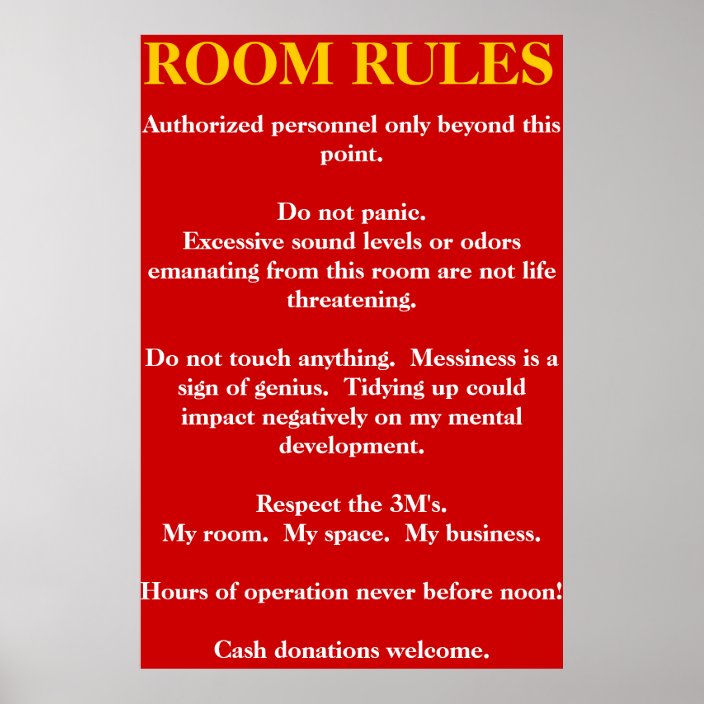Establishing a Safe and Organized Bedroom Environment

A clean and organized bedroom is not just about aesthetics; it plays a crucial role in a child’s well-being and productivity. A clutter-free space promotes a sense of calm and focus, allowing children to relax and concentrate better on their activities.
Bedroom Organization Techniques, Bedroom rules for kids
Organizing a child’s bedroom requires a tailored approach based on their age and developmental stage. Here are some techniques:
For Toddlers and Preschoolers:
– Use labeled containers: Colorful bins and baskets with labels or pictures can help toddlers identify and store their toys. This encourages them to put things away independently.
– Create designated play areas: Define a specific space for playing and another for sleeping, using rugs, dividers, or furniture arrangements. This helps toddlers understand boundaries and promotes organized play.
For Elementary School Children:
– Implement a “one in, one out” rule: Encourage children to donate or discard one item for every new item they bring into their room. This prevents excessive clutter and promotes mindful consumption.
– Utilize vertical space: Utilize shelves, wall-mounted organizers, and under-bed storage solutions to maximize space and keep belongings accessible.
For Teenagers:
– Invest in multi-functional furniture: Choose furniture with built-in storage compartments, such as beds with drawers, desks with shelves, or ottomans with hidden storage. This helps teenagers maximize space and keep their belongings organized.
– Utilize wall space: Hang mirrors, artwork, or decorative shelves to create visual interest and free up floor space. This allows teenagers to personalize their rooms while maintaining a sense of order.
Creating a Calming and Relaxing Atmosphere
A calming bedroom environment promotes relaxation and restful sleep. Here are some tips:
– Choose a soothing color palette: Opt for calming colors like light blues, greens, or pastels. These colors create a sense of tranquility and promote relaxation.
– Use soft lighting: Dimmable lamps or string lights create a warm and inviting atmosphere, ideal for bedtime routines. Avoid harsh overhead lights, which can be stimulating and disrupt sleep.
– Select comfortable furniture: Choose comfortable beds, chairs, and seating areas that encourage relaxation and quiet activities.
Setting Clear Expectations and Boundaries: Bedroom Rules For Kids

Setting clear expectations and boundaries for your child’s behavior in their bedroom is crucial for fostering a sense of responsibility, independence, and a healthy sleep routine. Consistent rules create a predictable and structured environment that promotes positive habits and minimizes conflict.
Age-Appropriate Rules
Creating rules tailored to your child’s age is essential for ensuring they are both understandable and enforceable.
- Toddlers (1-3 years old):
- Bedtime routine: Establish a consistent bedtime routine, including a warm bath, reading a book, and a goodnight kiss. This helps signal to your child that it’s time to sleep.
- Toy cleanup: Encourage your child to put away their toys before bedtime. You can make this fun by turning it into a game.
- Preschoolers (3-5 years old):
- Screen time limits: Set specific limits on screen time, and make sure it is not used in their bedroom.
- Guest behavior: Explain to your child how to be a good host and guest, including sharing toys and respecting personal space.
- Quiet time: Encourage quiet activities, like reading or drawing, before bedtime to promote relaxation.
- School-aged children (6-12 years old):
- Homework time: Establish a designated homework time and space in their bedroom.
- Chores: Assign age-appropriate chores, such as making their bed or putting away their clothes, to foster responsibility.
- Guest behavior: Discuss appropriate behavior when having friends over, including respecting your rules and the boundaries of their space.
- Teenagers (13-18 years old):
- Curfew: Set a reasonable curfew, especially when having friends over, to ensure their safety and your peace of mind.
- Privacy: Respect their privacy, but emphasize the importance of communicating about their activities and whereabouts.
- Responsibility: Encourage them to take responsibility for their actions and decisions, including cleaning their room and managing their belongings.
Benefits of Positive Reinforcement vs. Punishment
| Method | Benefits | Drawbacks |
|---|---|---|
| Positive Reinforcement |
|
|
| Punishment |
|
|
Fostering Independence and Responsibility

Bedroom rules for kids – Giving children a sense of ownership over their bedroom can empower them to be more responsible and independent. It’s about more than just keeping their space tidy – it’s about teaching them valuable life skills that will serve them well throughout their lives. Imagine a child who takes pride in their room, knowing they can contribute to the family’s well-being. That’s the power of fostering independence and responsibility in a child’s bedroom.
Age-Appropriate Chores and Tasks
Assigning age-appropriate chores and tasks helps children learn the importance of contributing to the household. These tasks can be as simple as putting away toys or making their bed, or more complex as they grow older, like folding laundry or helping with meal prep.
- Toddlers (1-3 years old): Putting away toys, helping to put clothes in the hamper, wiping up spills with a damp cloth.
- Preschoolers (3-5 years old): Making their bed (with help), picking up toys, helping to dust furniture, setting the table for meals.
- Elementary School Children (6-10 years old): Folding laundry, emptying trash cans, watering plants, helping with meal prep (like washing vegetables or stirring ingredients).
- Teenagers (11-18 years old): Vacuuming, cleaning their bathroom, doing their own laundry, taking care of their pets.
Involving Children in Bedroom Design
Let children express their creativity and individuality by involving them in the design and decoration of their bedroom. This gives them a sense of ownership and encourages them to take pride in their space. It also helps them develop decision-making skills and learn about their own preferences.
- Brainstorming Ideas: Start by discussing what kind of bedroom they envision. What colors, themes, or furniture do they like? Encourage them to look at magazines, online resources, or even visit furniture stores for inspiration.
- Creating a Mood Board: Once they have some ideas, help them create a mood board with pictures, fabric swatches, and paint samples. This visual representation will help them solidify their vision and communicate it to you.
- Making Choices: Involve them in the decision-making process. Let them choose furniture, bedding, curtains, and accessories. Even small choices, like choosing a lampshade or a throw pillow, can make a big difference in their sense of ownership.
- Decorating and Personalizing: Once the basic design is in place, encourage them to personalize their space with artwork, posters, or other items that reflect their interests and personality. This could include displaying their artwork, favorite photos, or souvenirs from trips.
Establishing clear bedroom rules for children is essential for fostering a sense of order and responsibility. While a dedicated play area within the bedroom is often ideal, space constraints may necessitate alternative solutions. For families living in a one bedroom apartment with backyard , the outdoor space can serve as an extension of the child’s play area, allowing for active engagement while minimizing noise and clutter indoors.
This approach encourages a healthy balance between indoor and outdoor play, promoting both physical and cognitive development.
Establishing clear bedroom rules for children is crucial for fostering a sense of responsibility and order. While enforcing these rules, it’s essential to create a comfortable and inviting space for them. A vintage shabby chic bedroom chair, such as those found on Jessica Abbott’s website , can add a touch of elegance and charm to the room, providing a designated spot for reading, relaxation, or simply enjoying quiet time.
This combination of structure and comfort can help children feel secure and valued within their own space.